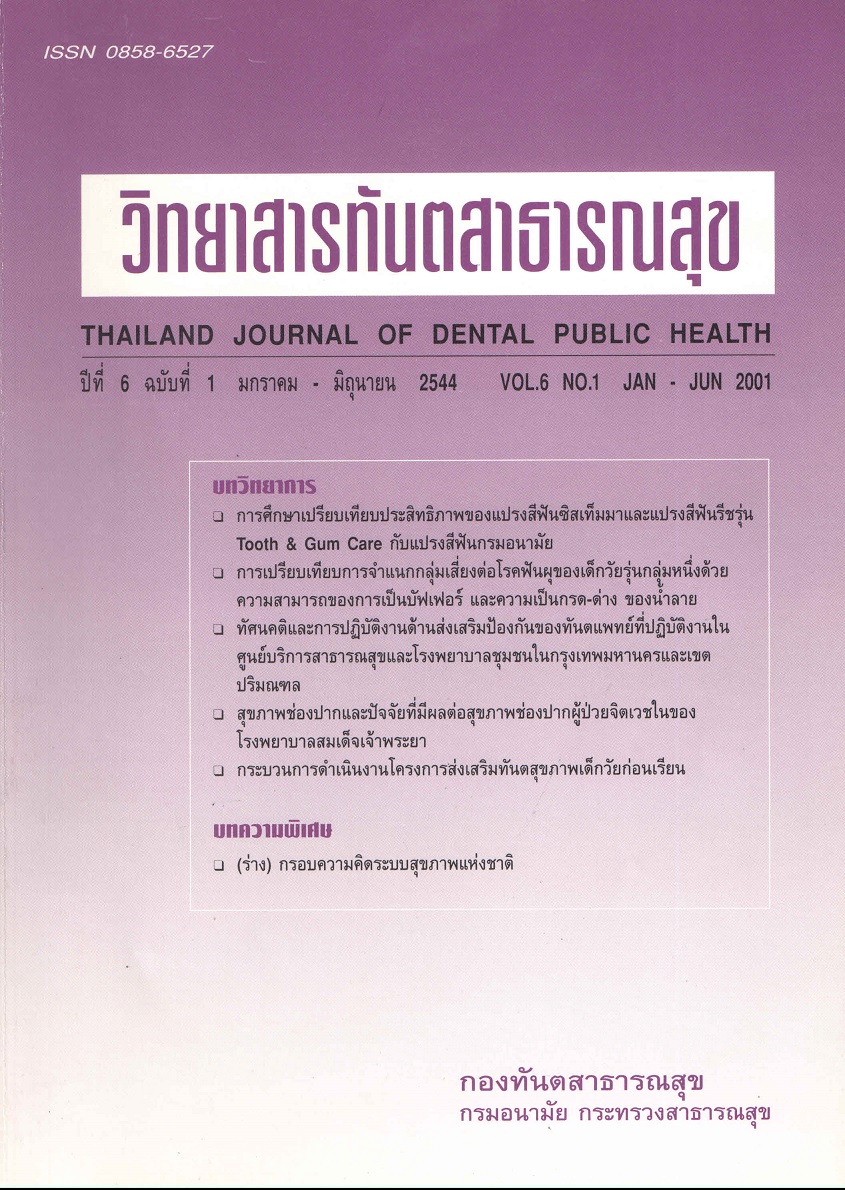The Comparison of Caries-risk identification in an adolescent group by buffer capacity of saliva and salivary pH.
Main Article Content
Abstract
Since salivary factors show a relationship to caries incidenc, this study was proposed to identify a caries-risk group by buffer capacity of saliva and salivary pH. Subjects were 13-15 year-old students in a Bangkok Metropolis secondary school. All subjects (157 males and 170 females) were healthy and had no clinical sign of salivary gland abnormality. The DMFT were recorded. After rinsing the mouth with water and chewing a piece of parafilm, stimulated saliva was collected for 5 minutes. Salivary pH was measured by a pH meter and the buffer capacity was determined by titration with hydrochloric acid. Data were analyzed by a simple correlation, F-test and LSD at 95% confidence limit. The results showed that buffer capacity significantly related with DMFT p < 0.05 with the correlation coefficient (r) = -0.255 but the salivary pH had no significant relationship (r = -0.045). When the buffer capacity of saliva were divided into low, medium and high capacity group, it was found that the DMFT of these 3 groups (2.84, 2.78 and 1.58 respectively) were significantly different p < 0.05. When the salivary pH were divided into low, medium and high pH group, it was found that the DMFT of these 3 groups (2.45, 2.21 and 2.13 respectively) showed no statistical difference. On the basis of these data, it was summarized that buffer capacity of saliva clearly identified a cariesrisk group but salivary pH showed no advantage.
Downloads
Article Details
References
2. Ericsson, Y.Clinical investigation of the salivary buffering action. Acta Odont Scand 1959; 17:131 – 65.
3. กองทันตสาธารณสุข กรมอนามัย กระทรวงสาธารณสุข รายงานผลการสํารวจสภาวะทันตสุขภาพแห่งชาติ ครั้งที่ 4 พ.ศ.2537 ประเทศไทย. ISBN 974-7995-79-4 หน้า 16
4. World Health Organization, Oral Health Survey. Basic methods 2nd ed. Geneva, 1977.
5. Marlay, E. The relationship between dental caries and salivary properties at ad Austral Dent J 1970; 15 : 412-22.
6. Frostell, G.A colourimetric screening test for evaluation of the buffer capacity of saliva. Swed Dent J.1980;4:81 - 6.
7. ปิยะดา ประเสริฐสม การจําแนกกลุ่มเสี่ยงต่อโรคฟันผุในเด็กอายุ 11-12 ปี เขตกรุงเทพมหานคร ว. ทันต.2537;1:17 25.
8. Dreizen S, Reed Al, Niederneier W, Spies TD : Sodium and potassium as constituents of human salivary buffers. J Dent Res 32 : 497-503, 1953.
9. Parvinen T, Larmus M : Age dependency of stimulated salivary flow rate pH and lactobacillus and yeast concentration J Dent Res. 1982;61:052-55.
10. Heintze U., Birkhed D., Njorn, H. : Secretion rate and buffer effect of resting and stimulated whole saliva as a function of age and sex. Swed Dent J. 1983;7:227-28.
11. Edgar, WM and O' Mullane, DM. Saliva and oral health 2nd ed. Thanet Press limited, 1996, London, p. 38.
12. Dewes,C. Factors influencing salivary flow rate and composition.In: Edgar, WM and O’ Mullane, DM. Saliva and oral health 2nd ed. Thanet Press limited, 1996, London, p.27-41
13. Thylstrup, A., Fejerskow, O. Textbook of Clinical Cariology 2nd ed 1994, Copenhagen, p 17 43.
14. ยุทธนา ปัญญางาม ดลฤดี แก้วสวาท อรพินธ์ อัจฉรานุกุล. การกําจัดน้ําตาลกลูโคสและคุณสมบัติความเป็นบัฟเฟอร์ของน้ําลายในกลุ่มที่มีฟันผุมากและกลุ่มที่มีฟันผุน้อย.ว.ทันต. จุฬา 2536;2:101 - 10.


